Creek vs Filipino Community Comparison
COMPARE
Creek
Filipino
Social Comparison
Social Comparison
Creek
Filipinos
2,959
SOCIAL INDEX
27.1/ 100
SOCIAL RATING
237th/ 347
SOCIAL RANK
9,951
SOCIAL INDEX
97.0/ 100
SOCIAL RATING
5th/ 347
SOCIAL RANK
Filipino Integration in Creek Communities
The statistical analysis conducted on geographies consisting of 121,283,083 people shows a poor negative correlation between the proportion of Filipinos within Creek communities in the United States with a correlation coefficient (R) of -0.198. On average, for every 1% (one percent) increase in Creek within a typical geography, there is a decrease of 0.012% in Filipinos. To illustrate, in a geography comprising of 100,000 individuals, a rise of 1,000 Creek corresponds to a decrease of 12.0 Filipinos.
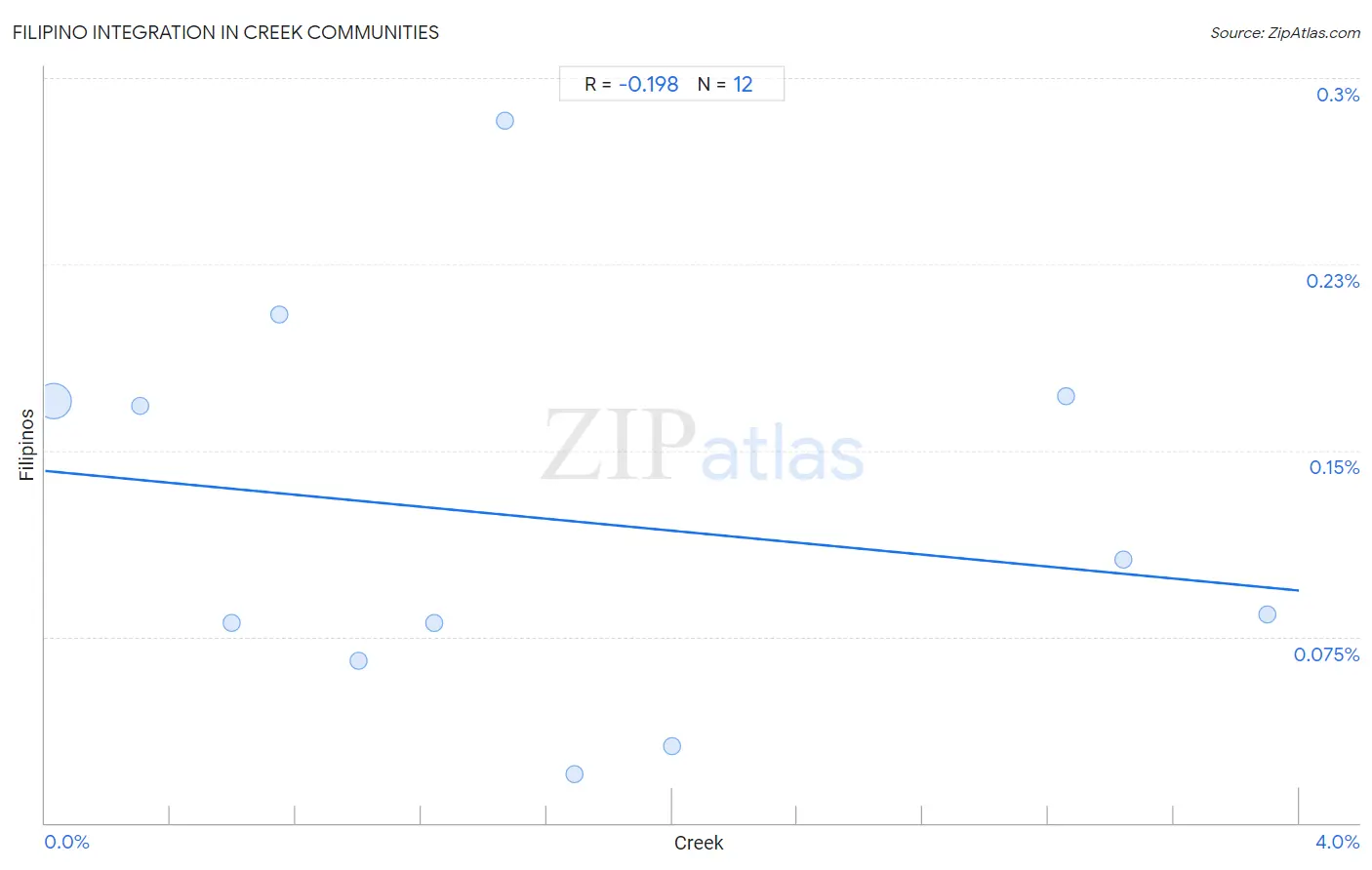
Creek vs Filipino Income
When considering income, the most significant differences between Creek and Filipino communities in the United States are seen in householder income ages 25 - 44 years ($74,847 compared to $128,723, a difference of 72.0%), householder income ages 45 - 64 years ($78,960 compared to $134,910, a difference of 70.9%), and median household income ($67,715 compared to $115,509, a difference of 70.6%). Conversely, both communities are more comparable in terms of wage/income gap (27.1% compared to 29.7%, a difference of 9.5%), householder income under 25 years ($45,371 compared to $57,740, a difference of 27.3%), and householder income over 65 years ($51,949 compared to $76,686, a difference of 47.6%).

| Income Metric | Creek | Filipino |
| Per Capita Income | Tragic $35,546 | Exceptional $59,066 |
| Median Family Income | Tragic $82,560 | Exceptional $138,397 |
| Median Household Income | Tragic $67,715 | Exceptional $115,509 |
| Median Earnings | Tragic $39,648 | Exceptional $61,197 |
| Median Male Earnings | Tragic $46,594 | Exceptional $74,224 |
| Median Female Earnings | Tragic $33,437 | Exceptional $49,508 |
| Householder Age | Under 25 years | Tragic $45,371 | Exceptional $57,740 |
| Householder Age | 25 - 44 years | Tragic $74,847 | Exceptional $128,723 |
| Householder Age | 45 - 64 years | Tragic $78,960 | Exceptional $134,910 |
| Householder Age | Over 65 years | Tragic $51,949 | Exceptional $76,686 |
| Wage/Income Gap | Tragic 27.1% | Tragic 29.7% |
Creek vs Filipino Poverty
When considering poverty, the most significant differences between Creek and Filipino communities in the United States are seen in child poverty under the age of 5 (24.2% compared to 11.6%, a difference of 108.6%), child poverty among boys under 16 (21.5% compared to 11.1%, a difference of 93.8%), and child poverty under the age of 16 (21.5% compared to 11.1%, a difference of 93.4%). Conversely, both communities are more comparable in terms of seniors poverty over the age of 75 (11.6% compared to 11.4%, a difference of 1.1%), seniors poverty over the age of 65 (10.9% compared to 9.7%, a difference of 12.2%), and female poverty among 18-24 year olds (24.2% compared to 19.0%, a difference of 27.5%).
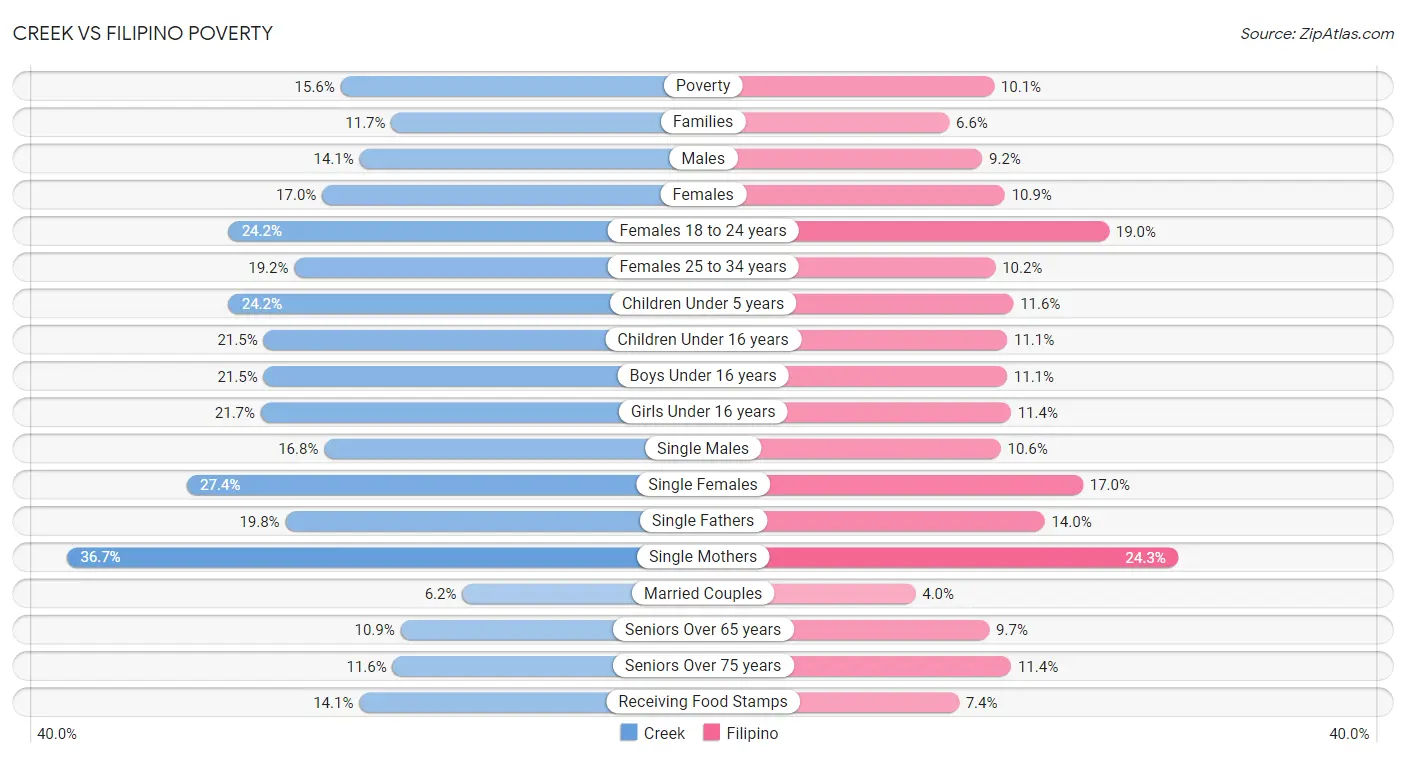
| Poverty Metric | Creek | Filipino |
| Poverty | Tragic 15.6% | Exceptional 10.1% |
| Families | Tragic 11.7% | Exceptional 6.6% |
| Males | Tragic 14.1% | Exceptional 9.2% |
| Females | Tragic 17.0% | Exceptional 10.9% |
| Females 18 to 24 years | Tragic 24.2% | Exceptional 19.0% |
| Females 25 to 34 years | Tragic 19.2% | Exceptional 10.2% |
| Children Under 5 years | Tragic 24.2% | Exceptional 11.6% |
| Children Under 16 years | Tragic 21.5% | Exceptional 11.1% |
| Boys Under 16 years | Tragic 21.5% | Exceptional 11.1% |
| Girls Under 16 years | Tragic 21.7% | Exceptional 11.4% |
| Single Males | Tragic 16.8% | Exceptional 10.6% |
| Single Females | Tragic 27.4% | Exceptional 17.0% |
| Single Fathers | Tragic 19.8% | Exceptional 14.0% |
| Single Mothers | Tragic 36.7% | Exceptional 24.3% |
| Married Couples | Tragic 6.2% | Exceptional 4.0% |
| Seniors Over 65 years | Average 10.9% | Exceptional 9.7% |
| Seniors Over 75 years | Exceptional 11.6% | Exceptional 11.4% |
| Receiving Food Stamps | Tragic 14.1% | Exceptional 7.4% |
Creek vs Filipino Unemployment
When considering unemployment, the most significant differences between Creek and Filipino communities in the United States are seen in unemployment among women with children under 6 years (8.9% compared to 6.1%, a difference of 45.3%), unemployment among ages 30 to 34 years (6.6% compared to 4.8%, a difference of 36.3%), and unemployment among ages 35 to 44 years (5.4% compared to 4.0%, a difference of 32.5%). Conversely, both communities are more comparable in terms of unemployment among youth under 25 years (11.2% compared to 11.1%, a difference of 0.53%), unemployment among seniors over 75 years (7.8% compared to 7.9%, a difference of 1.0%), and unemployment among ages 20 to 24 years (9.7% compared to 10.1%, a difference of 3.4%).
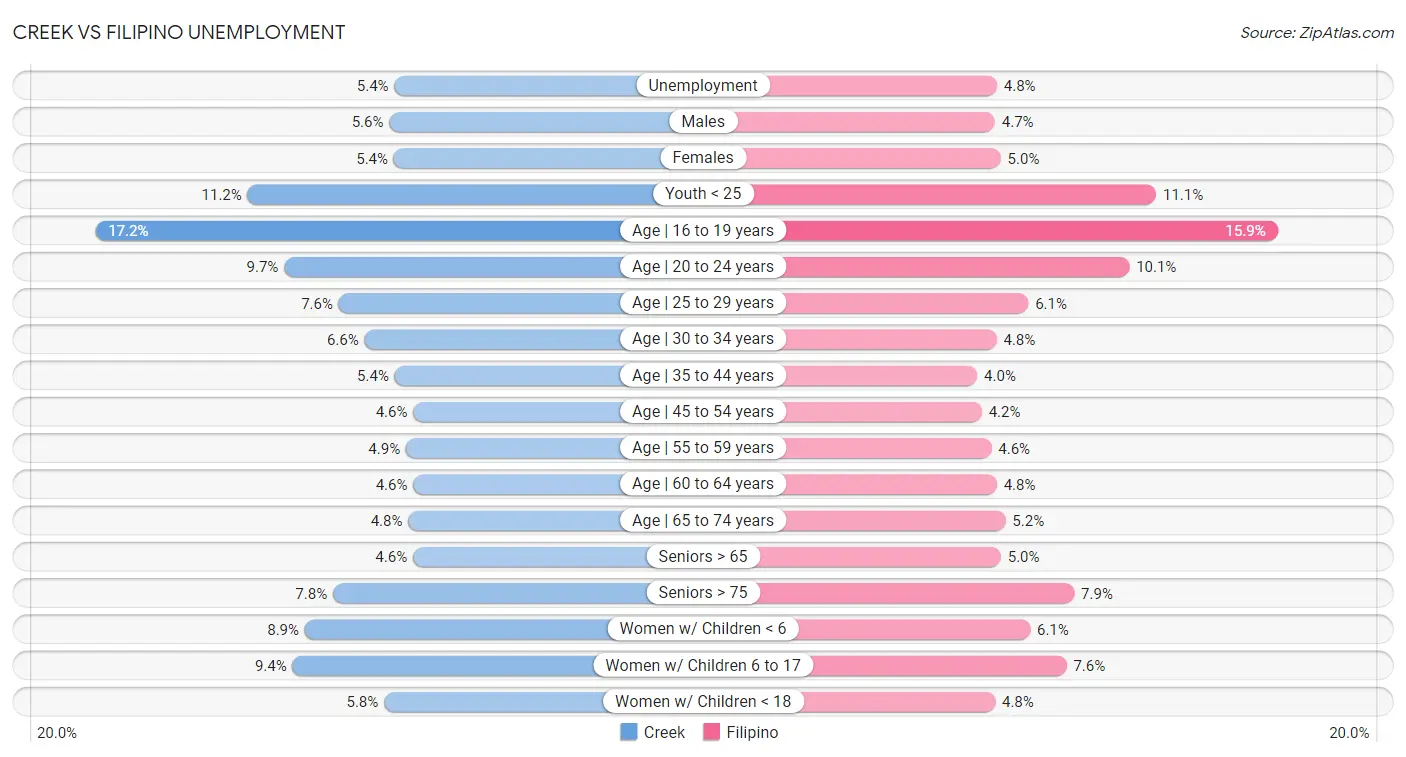
| Unemployment Metric | Creek | Filipino |
| Unemployment | Poor 5.4% | Exceptional 4.8% |
| Males | Tragic 5.6% | Exceptional 4.7% |
| Females | Poor 5.4% | Exceptional 5.0% |
| Youth < 25 | Exceptional 11.2% | Exceptional 11.1% |
| Age | 16 to 19 years | Excellent 17.2% | Exceptional 15.9% |
| Age | 20 to 24 years | Exceptional 9.7% | Exceptional 10.1% |
| Age | 25 to 29 years | Tragic 7.6% | Exceptional 6.1% |
| Age | 30 to 34 years | Tragic 6.6% | Exceptional 4.8% |
| Age | 35 to 44 years | Tragic 5.4% | Exceptional 4.0% |
| Age | 45 to 54 years | Poor 4.6% | Exceptional 4.2% |
| Age | 55 to 59 years | Poor 4.9% | Exceptional 4.6% |
| Age | 60 to 64 years | Exceptional 4.6% | Good 4.8% |
| Age | 65 to 74 years | Exceptional 4.8% | Exceptional 5.2% |
| Seniors > 65 | Exceptional 4.6% | Exceptional 5.0% |
| Seniors > 75 | Exceptional 7.8% | Exceptional 7.9% |
| Women w/ Children < 6 | Tragic 8.9% | Exceptional 6.1% |
| Women w/ Children 6 to 17 | Tragic 9.4% | Exceptional 7.6% |
| Women w/ Children < 18 | Tragic 5.8% | Exceptional 4.8% |
Creek vs Filipino Labor Participation
When considering labor participation, the most significant differences between Creek and Filipino communities in the United States are seen in in labor force | age 16-19 (39.1% compared to 31.7%, a difference of 23.6%), in labor force | age > 16 (61.3% compared to 65.9%, a difference of 7.5%), and in labor force | age 45-54 (77.7% compared to 83.5%, a difference of 7.4%). Conversely, both communities are more comparable in terms of in labor force | age 20-24 (74.5% compared to 71.4%, a difference of 4.4%), in labor force | age 25-29 (80.7% compared to 84.9%, a difference of 5.3%), and in labor force | age 35-44 (80.0% compared to 84.7%, a difference of 5.9%).

| Labor Participation Metric | Creek | Filipino |
| In Labor Force | Age > 16 | Tragic 61.3% | Exceptional 65.9% |
| In Labor Force | Age 20-64 | Tragic 75.1% | Exceptional 80.1% |
| In Labor Force | Age 16-19 | Exceptional 39.1% | Tragic 31.7% |
| In Labor Force | Age 20-24 | Poor 74.5% | Tragic 71.4% |
| In Labor Force | Age 25-29 | Tragic 80.7% | Excellent 84.9% |
| In Labor Force | Age 30-34 | Tragic 80.4% | Exceptional 85.5% |
| In Labor Force | Age 35-44 | Tragic 80.0% | Exceptional 84.7% |
| In Labor Force | Age 45-54 | Tragic 77.7% | Exceptional 83.5% |
Creek vs Filipino Family Structure
When considering family structure, the most significant differences between Creek and Filipino communities in the United States are seen in births to unmarried women (37.6% compared to 23.0%, a difference of 63.5%), single mother households (7.0% compared to 4.7%, a difference of 49.6%), and divorced or separated (14.4% compared to 9.9%, a difference of 45.4%). Conversely, both communities are more comparable in terms of average family size (3.20 compared to 3.20, a difference of 0.060%), family households (64.2% compared to 65.9%, a difference of 2.7%), and family households with children (27.4% compared to 28.6%, a difference of 4.3%).

| Family Structure Metric | Creek | Filipino |
| Family Households | Fair 64.2% | Exceptional 65.9% |
| Family Households with Children | Fair 27.4% | Exceptional 28.6% |
| Married-couple Households | Tragic 45.3% | Exceptional 51.0% |
| Average Family Size | Poor 3.20 | Poor 3.20 |
| Single Father Households | Tragic 2.6% | Exceptional 1.8% |
| Single Mother Households | Tragic 7.0% | Exceptional 4.7% |
| Currently Married | Poor 46.0% | Exceptional 49.7% |
| Divorced or Separated | Tragic 14.4% | Exceptional 9.9% |
| Births to Unmarried Women | Tragic 37.6% | Exceptional 23.0% |
Creek vs Filipino Vehicle Availability
When considering vehicle availability, the most significant differences between Creek and Filipino communities in the United States are seen in no vehicles in household (7.8% compared to 10.4%, a difference of 33.8%), 3 or more vehicles in household (21.9% compared to 20.8%, a difference of 5.4%), and 4 or more vehicles in household (7.2% compared to 6.9%, a difference of 4.0%). Conversely, both communities are more comparable in terms of 2 or more vehicles in household (58.3% compared to 57.8%, a difference of 0.76%), 1 or more vehicles in household (92.3% compared to 89.7%, a difference of 2.9%), and 4 or more vehicles in household (7.2% compared to 6.9%, a difference of 4.0%).

| Vehicle Availability Metric | Creek | Filipino |
| No Vehicles Available | Exceptional 7.8% | Average 10.4% |
| 1+ Vehicles Available | Exceptional 92.3% | Average 89.7% |
| 2+ Vehicles Available | Exceptional 58.3% | Exceptional 57.8% |
| 3+ Vehicles Available | Exceptional 21.9% | Exceptional 20.8% |
| 4+ Vehicles Available | Exceptional 7.2% | Exceptional 6.9% |
Creek vs Filipino Education Level
When considering education level, the most significant differences between Creek and Filipino communities in the United States are seen in doctorate degree (1.3% compared to 3.4%, a difference of 155.1%), professional degree (3.1% compared to 7.6%, a difference of 144.3%), and master's degree (10.5% compared to 23.4%, a difference of 122.7%). Conversely, both communities are more comparable in terms of 9th grade (95.6% compared to 95.6%, a difference of 0.040%), nursery school (98.4% compared to 98.1%, a difference of 0.35%), and kindergarten (98.4% compared to 98.0%, a difference of 0.36%).
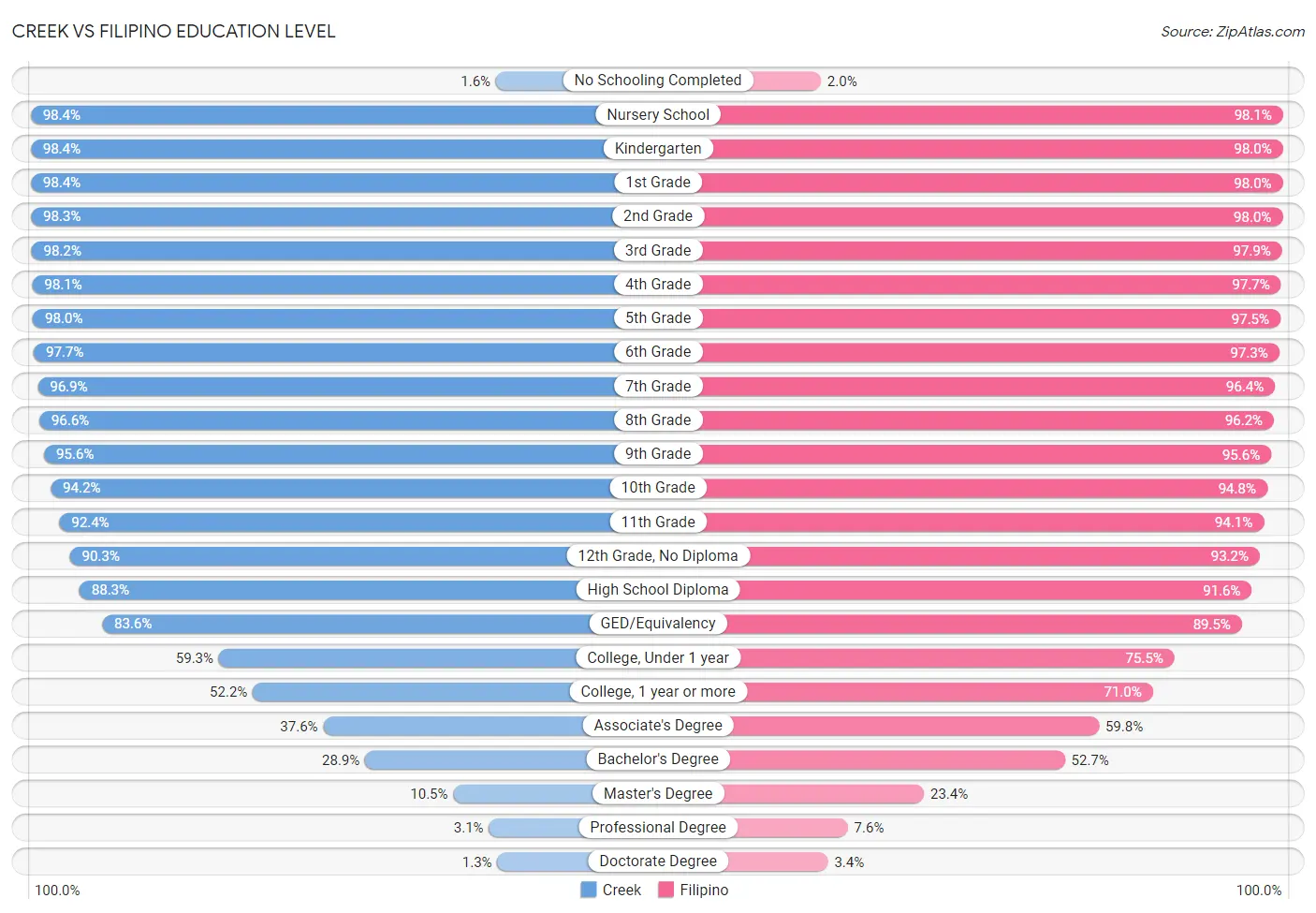
| Education Level Metric | Creek | Filipino |
| No Schooling Completed | Exceptional 1.6% | Excellent 2.0% |
| Nursery School | Exceptional 98.4% | Good 98.1% |
| Kindergarten | Exceptional 98.4% | Good 98.0% |
| 1st Grade | Exceptional 98.4% | Good 98.0% |
| 2nd Grade | Exceptional 98.3% | Good 98.0% |
| 3rd Grade | Exceptional 98.2% | Good 97.9% |
| 4th Grade | Exceptional 98.1% | Excellent 97.7% |
| 5th Grade | Exceptional 98.0% | Excellent 97.5% |
| 6th Grade | Exceptional 97.7% | Excellent 97.3% |
| 7th Grade | Exceptional 96.9% | Exceptional 96.4% |
| 8th Grade | Exceptional 96.6% | Exceptional 96.2% |
| 9th Grade | Exceptional 95.6% | Exceptional 95.6% |
| 10th Grade | Exceptional 94.2% | Exceptional 94.8% |
| 11th Grade | Average 92.4% | Exceptional 94.1% |
| 12th Grade, No Diploma | Tragic 90.3% | Exceptional 93.2% |
| High School Diploma | Tragic 88.3% | Exceptional 91.6% |
| GED/Equivalency | Tragic 83.6% | Exceptional 89.5% |
| College, Under 1 year | Tragic 59.3% | Exceptional 75.5% |
| College, 1 year or more | Tragic 52.2% | Exceptional 71.0% |
| Associate's Degree | Tragic 37.6% | Exceptional 59.8% |
| Bachelor's Degree | Tragic 28.9% | Exceptional 52.7% |
| Master's Degree | Tragic 10.5% | Exceptional 23.4% |
| Professional Degree | Tragic 3.1% | Exceptional 7.6% |
| Doctorate Degree | Tragic 1.3% | Exceptional 3.4% |
Creek vs Filipino Disability
When considering disability, the most significant differences between Creek and Filipino communities in the United States are seen in disability age 35 to 64 (16.9% compared to 8.0%, a difference of 109.8%), vision disability (3.2% compared to 1.7%, a difference of 90.2%), and ambulatory disability (8.5% compared to 4.9%, a difference of 73.6%). Conversely, both communities are more comparable in terms of cognitive disability (18.3% compared to 16.4%, a difference of 11.5%), disability age over 75 (51.5% compared to 45.4%, a difference of 13.3%), and self-care disability (2.8% compared to 2.2%, a difference of 31.6%).
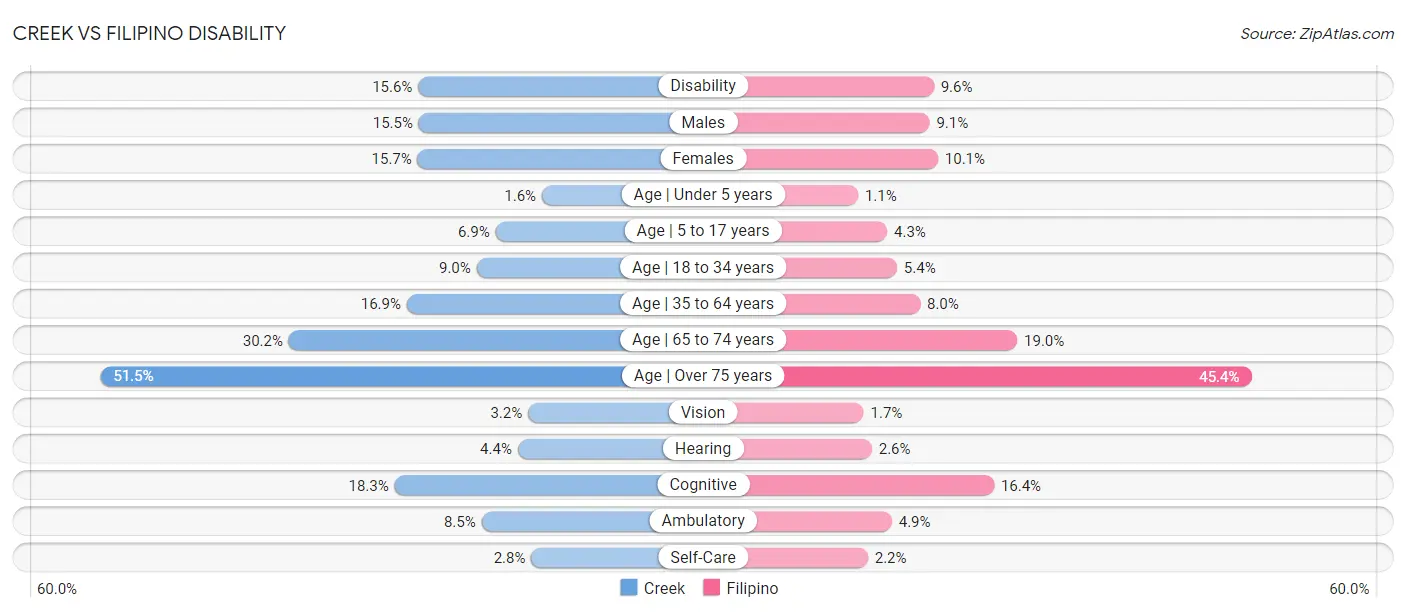
| Disability Metric | Creek | Filipino |
| Disability | Tragic 15.6% | Exceptional 9.6% |
| Males | Tragic 15.5% | Exceptional 9.1% |
| Females | Tragic 15.7% | Exceptional 10.1% |
| Age | Under 5 years | Tragic 1.6% | Exceptional 1.1% |
| Age | 5 to 17 years | Tragic 6.9% | Exceptional 4.3% |
| Age | 18 to 34 years | Tragic 9.0% | Exceptional 5.4% |
| Age | 35 to 64 years | Tragic 16.9% | Exceptional 8.0% |
| Age | 65 to 74 years | Tragic 30.2% | Exceptional 19.0% |
| Age | Over 75 years | Tragic 51.5% | Exceptional 45.4% |
| Vision | Tragic 3.2% | Exceptional 1.7% |
| Hearing | Tragic 4.4% | Exceptional 2.6% |
| Cognitive | Tragic 18.3% | Exceptional 16.4% |
| Ambulatory | Tragic 8.5% | Exceptional 4.9% |
| Self-Care | Tragic 2.8% | Exceptional 2.2% |